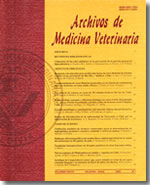Annual study of the of egg and oocyst outputs of gastrointestinal parasites and lungworm larvae in a sheep station of Magallanes, Chile
Main Article Content
Abstract
In order to obtain epidemiological data of gastrointestinal and lungworm parasitosis in sheep in Magallanes, Chile, a survey was carried out at the "Entre Vientos" station during a year (September 1999 to August 2000). The tendencies of egg, oocyst and larvae outputs of parasites were determined in 3 age categories of sheep: 9.000 lambs (born in spring 1999), 1.800 ewe hoggets (1 year old) and 13.500 ewes (2 or more years old), which were all kept under the traditional management system of the station.
Every 14 days, faeces were obtained from the rectum of 25 animals from each age category, sampled at random, to carry out egg counts and differentiation of gastrointestinal worm larvae, counts of cestode eggs, determination of animals that were positive to oocysts of intestinal protozoa and detection of lungworm larvae.
Lambs showed the greatest egg output of gastrointestinal worms during the summer, with predominance of the genus Nematodirus and Ostertagia. In ewe hoggets and ewes, the greatest output of Ostertagia and Trichostrongylus were produced in spring (November), coinciding with the temperature rise. The most contaminating category was the ewes in spring, whereas the lambs were in the summer. During spring, most of the animals were positive to Eimeria spp., but the lambs were the ones with more oocyst output. The greatest oviposition of Moniezia expansa eggs was registered in lambs and ewe hoggets during summer and spring respectively. Dictyocaulus filaria larvae were principally detected in lambs during autumn and winter.
No cases of clinic parasitosis were diagnosed during the survey. The reason for this can be the extensive grazing system and the seasonal moving of the animals all over the farm surface.

